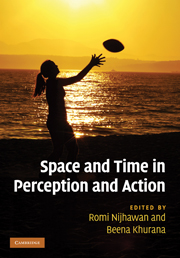Book contents
- Frontmatter
- Contents
- List of contributors
- Acknowledgments
- 1 Space and time: the fabric of thought and reality
- Part I Time–space during action: perisaccadic mislocalization and reaching
- 2 The internal eye position signal, psychophysics, and neurobiology
- 3 Factors influencing perisaccadic visual mislocalization
- 4 Visual and nonvisual factors in perisaccadic compression of space
- 5 Keeping vision stable: rapid updating of spatiotopic receptive fields may cause relativistic-like effects
- 6 Combined influences of extraretinal signals, retinal signals, and visual induction on space perception and manual behavior in perisaccadic and steady viewing
- 7 Space constancy: the rise and fall of perceptual compensation
- 8 Intercepting moving objects: do eye movements matter?
- 9 The utility of visual motion for goal-directed reaching
- Part II Temporal phenomena: perception
- Part III Temporal phenomena: binding and asynchrony
- Part IV Spatial phenomena: forward shift effects
- Part V Space–time and awareness
- Index
- References
3 - Factors influencing perisaccadic visual mislocalization
from Part I - Time–space during action: perisaccadic mislocalization and reaching
Published online by Cambridge University Press: 05 October 2010
- Frontmatter
- Contents
- List of contributors
- Acknowledgments
- 1 Space and time: the fabric of thought and reality
- Part I Time–space during action: perisaccadic mislocalization and reaching
- 2 The internal eye position signal, psychophysics, and neurobiology
- 3 Factors influencing perisaccadic visual mislocalization
- 4 Visual and nonvisual factors in perisaccadic compression of space
- 5 Keeping vision stable: rapid updating of spatiotopic receptive fields may cause relativistic-like effects
- 6 Combined influences of extraretinal signals, retinal signals, and visual induction on space perception and manual behavior in perisaccadic and steady viewing
- 7 Space constancy: the rise and fall of perceptual compensation
- 8 Intercepting moving objects: do eye movements matter?
- 9 The utility of visual motion for goal-directed reaching
- Part II Temporal phenomena: perception
- Part III Temporal phenomena: binding and asynchrony
- Part IV Spatial phenomena: forward shift effects
- Part V Space–time and awareness
- Index
- References
Summary
Summary
This chapter is a critical review and discussion of psychophysical studies on perisaccadic visual mislocalization. In particular, it focuses on factors influencing the mislocalization curves. The chapter is organized as follows: first some findings on perisaccadic mislocalization observed in complete darkness are reviewed, followed by empirical and theoretical considerations on eye position signals estimated psychophysically from the mislocalization curves. Next, issues on mislocalization in a lit environment are discussed. Finally, findings on perisaccadic perceptual effects of flickering stimulus are reviewed. Although our understanding of how saccadic eye movements affect visual localization has advanced dramatically in recent years, we probably have only a crude outline of the phenomena and, therefore, further research is needed.
Visual mislocalization in the dark
Basic findings
In a saccade, the projection of the world sweeps across the retina at high speed. Nevertheless, we usually do not notice this visual motion, and the world continues to appear visually stable. This perceptual phenomenon is called “visual stability.”
Although visual stability is preserved during saccades under normal conditions, the perception of the position of objects flashed before, during, or just after a saccade is altered. Examinations into perisaccadic mislocalization were first made in the 1960s by Matin and his colleagues (Matin & Pearce 1965; Matin et al. 1969, 1970). They reported that errors in perceptual localization occurred before the saccade onset and finished slightly after it. Subsequent studies showed essentially the same results (Honda 1989, 1990, 1991; Dassonville et al. 1992, 1995; Sogo & Osaka, 2001).
- Type
- Chapter
- Information
- Space and Time in Perception and Action , pp. 19 - 37Publisher: Cambridge University PressPrint publication year: 2010



